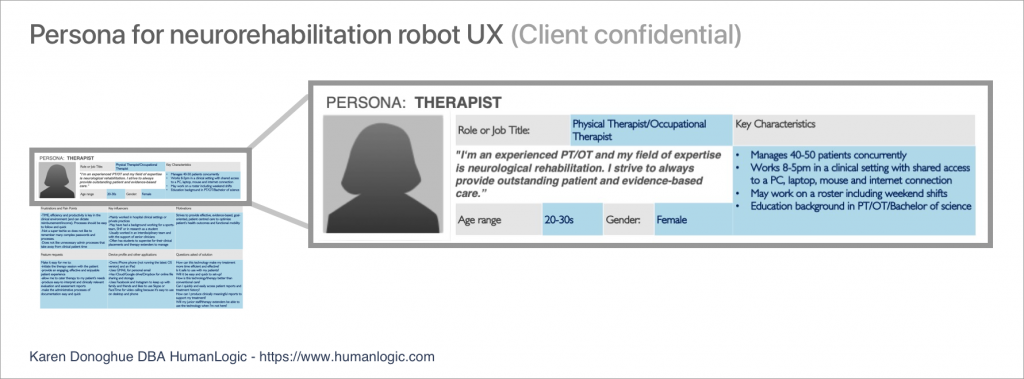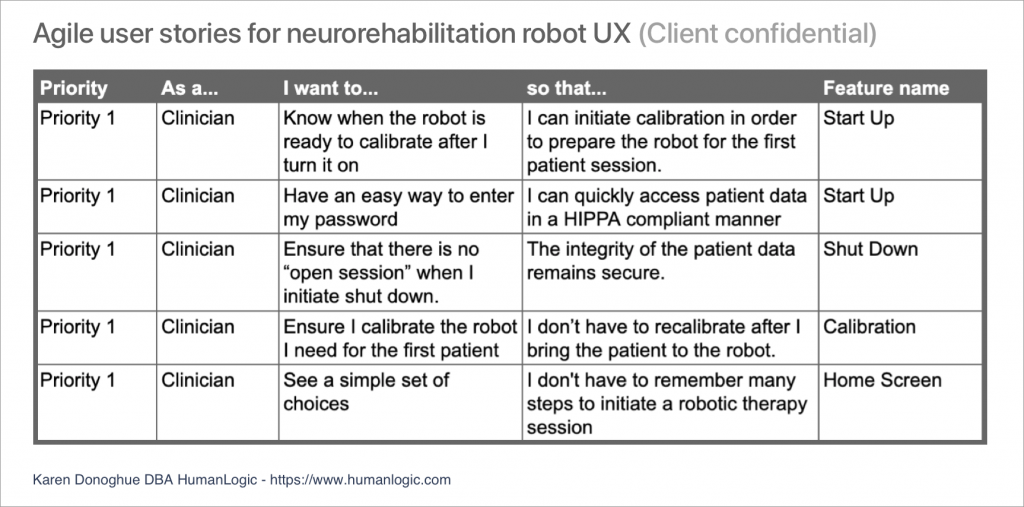HUMANLOGIC CLIENT: CONFIDENTIAL
Design a new and highly usable User Experience for a neurorehabilitation robot
PRACTICE AREAS
Product Planning, Requirements validation, UX Strategy and RFP for software development
SUMMARY
- Led highly collaborative approach with Product and Engineering teams to validate requirements and user experience of robot software UI.
- Designed a new easy-to-use self-service robot management experience for rehabilitation therapists and the patient therapy user experience.
- Prepared RFP for executive team to source resources to build software UI.
CLIENT PROFILE (CONFIDENTIAL CLIENT)
Client is a global robotics company focused on providing rehabilitation and assistive technology solutions to individuals with neurological and mobility challenges from hospital to home. Client’s healthcare robots enables clinicians to efficiently deliver intensive motor therapy to help patients regain motor function following a neurological condition or injury. These robots monitor patients’ movements during rehabiliation therapy and provide assistance on an “as-needed” basis to help the patient complete motor therapy activities.
Client’s robots are used for neurorehabilitation in more than 20 countries and research has shown the robots to be effective for a wide range of motor impairments including stroke, Cerebral Palsy, Spinal Cord Injury, Multiple Sclerosis and other neurological conditions.

PRODUCT DESIGN PROCESS
Working closely with the Client’s Product Management and Engineering team, I participated in product planning, feature definition and workflow design for a MVP UX definition of a new version of the robot, devices that are precisely calibrated for neurorehabilitation therapy sessions. The goals for the product UX design included the design of a highly usable “self-service” user experience that would not require special training or a lengthy onboarding process.
I began working with the Product Management (PM) team on persona design. We defined personas for clinical neuro rehabilitation professionals – Physical Therapists and Occupational Therapists and their specific needs, pain points, motivations and unique requirements.

Example of Therapist persona resulting from user research collaboration with the Client’s Product team.
A stated goal in the product planning process included ensuring patient privacy and enabling a good user experience for therapists as well as patients. From speaking with a neuro rehab therapist on the Client product team I learned that therapists who work on manual rehab with stroke patients often themselves suffer repetitive strain injuries.
After working through the personas, we proceeded to feature definition and prioritization using Agile development methods. Working with the Product Manager and the neuro rehab therapist who was a part of the product team, we reviewed and prioritized user stories, features and the user experience flows for initiating, managing and reporting on patient therapy. Major flows that we worked through included authenticating to the system while ensuring patient privacy, calibrating the robot in preparation for patient therapy sessions, and allowing the therapist to run reports.

Prioritized Agile user stories written from the point of view of the Clinician user persona.
After the user stories were analyzed and prioritized, I proceeded to map the user stories to flows associated with the key system interactions such as Startup of the Robot, Robot Calibration, Onboarding a new Patient, and Performing Therapy.
Collaborating with the product team and gathering feedback through calls and using cloud-based shared documentation tools, I translated the MVP requirements into flows and rough wireframes delivered to the Software Architect on the Engineering team. In addition, I took on the task of writing a Request for Proposal (RFP) to facilitate sourcing of software development resources to work on building the software.
RESULTS
The highly collaborative and cost-effective approach we took for this project enabled the Executive, Product and Software Engineering teams to rapidly define and validate product requirements to release an updated and modern software user experience for the Client’s neurorehabilitation robot.
My deliverables on this project included:
- Facilitation of Agile process to document product requirements with the product development team, analysis of Agile user stories, and rapid flow development
- Working with a practicing neurorehabilitation therapist and domain expert for stroke treatment to ensure that designs supported enhanced clinician and patient workflows
- Production of flows and wireframes for a modern web application front end experience for the robot
- Developed written RFP to facilitate sourcing of development resources to build the robot’s UI software
The resulting implementation of the software UI for the updated robot based on the new design has resulted in an improved clinician user experience that now features:
- Simple menus to calibrate and perform robotic therapy
- A streamlined workflow for therapists
- Easy report generation
The updated robotic device was released into the market in 2019. The enhanced GUI design platform resulting from this project has been extended to all of Client’s robots to enhance the user experience, data management, and connectivity of devices within the overall rehabilitation portfolio.
FOR MORE INFORMATION
For more information on how Karen Donoghue DBA HumanLogic can help with designing and improving your software product user experiences please visit www.humanlogic.com.